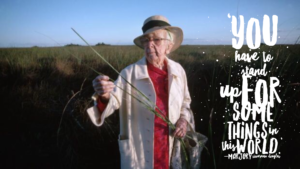
I heard the name of the high school where this month’s school shooting took place referred to in news reports by it’s full name, “Marjory Stoneman Douglas High School,” then shortened to “Stoneman Douglas,” then to “the school in Parkland Florida, or just “Parkland.” Turns out the names of all the other schools where shootings occurred, like Columbine, were named after their locations, not after an actual person. When the name “Marjory,” was dropped, I got especially curious about who she was. How did she become important enough to have a school named after her. Whoever she was, and whatever she did, I was fairly sure that she and her family would not want this event to be the way she will be remembered by this generation.
Finding online some details about Marjory’s long and illustrious life, I wondered how well the students at the school named after her knew her and the uncanny similarities and connections between their lives and hers. As a women’s suffrage advocate, she learned what it takes to change the constitution, and gain the right to vote for all the women in the US. She too experienced crime and criminals when her husband, Kenneth Douglas, attempted to scam her father out of money. She knew of mental illness, having experienced her mother’s illness and several bouts of her own.
As a journalist, she knew how to get the word out about injustice in her many articles and short stories. Her 1947 book, The Everglades: River of Grass galvanized people to protect the Everglades. Like Rachel Carson’s 1962 exposé Silent Spring about the dangers of DDT, both books had an immediate political effect.
Florida’s Governor in her time, Lawton Chiles, called her “the first voice to really wake a lot of us up to what we were doing to our quality of life, …a prophet, calling out to us to save the environment for our children and our grandchildren.
Now these high school students, the grandchildren she spoke about, are calling us out to save our schools, our children and our democracy. Instead of shortening or erasing her name, let’s keep Marjory’s memory and inspiration alive. I see t-shirts and banners asking the question, “What would Marjory Do? Her life reminds parents and grandparents, this is not just a project for the young. Marjory began her environmental work at age 79 and continued it until nearly the end of her life at age 108. Let’s be heartened by a quote from her that seems to apply to us especially in our day, “There is always a need to carry on.”

